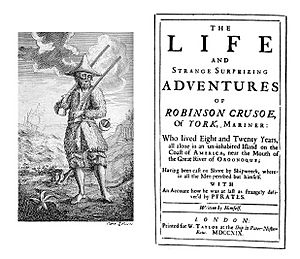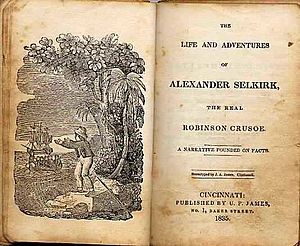Robinson Crusoe facts for kids

Title page from the first edition
|
|
| Author | Daniel Defoe |
|---|---|
| Illustrator | Single engraving by John Clark and John Pine after design by unknown artist |
| Country | United Kingdom |
| Language | English |
| Genre | adventure, historical fiction |
| Publisher | W. Taylor |
|
Publication date
|
25 April 1719 |
| Followed by | The Farther Adventures of Robinson Crusoe |
Robinson Crusoe is a novel written by Daniel Defoe. It was first published on 25 April 1719 by William Taylor.
The novel's full title is The Life and Strange Surprizing Adventures of Robinson Crusoe, Of York, Mariner: Who lived Eight and Twenty Years, all alone in an un-inhabited Island on the Coast of America, near the Mouth of the Great River of Oroonoque; Having been cast on Shore by Shipwreck, wherein all the Men perished but himself. With An Account how he was at last as strangely deliver'd by Pyrates.
The book is a fictional autobiography of the title character, Robinson Crusoe. Crusoe leaves the safety of his comfortable middle-class home in England and goes to sea. He is shipwrecked and becomes a castaway who spends years on a remote tropical island near Trinidad. He meets cannibals, captives and mutineers, and is eventually rescued.
For the first edition, Defoe pretended that the novel was a true story. He said the fictional protagonist Robinson Crusoe was the author and he pretended to be the editor of Crusoe's autobiography. This led many readers to believe that Crusoe was a real person and the book a true account of his life.
Many people think the story was influenced by the life of Alexander Selkirk. Selkirk was a Scottish castaway who lived for over four years on a Pacific island belonging to Chile called Más a Tierra. (In 1966, the island was renamed Robinson Crusoe Island.) However, there are other possible sources. For example, Ibn Tufail's earlier novel Hayy ibn Yaqdhan, also set on a desert island, may have inspired Defoe.
Pedro Luis Serrano was supposed to be a Spanish sailor who was marooned for seven or eight years on a small desert island after shipwrecking in the 1520s on a small island in the Caribbean off the coast of Nicaragua. He had no access to fresh water and lived off the blood and flesh of sea turtles and birds. He was quite a celebrity when he returned to Europe; before passing away, he recorded the hardships suffered in documents that show the endless anguish and suffering, the product of absolute abandonment to his fate, now held in the General Archive of the Indies, in Seville. There is some doubt of the historicity of the tale; nonetheless it is possible that Defoe heard his story in one of his visits to Spain before becoming a writer.
Critical response to Robinson Crusoe has been diverse and argumentative. There has been widespread disagreement about the novel's nature and origin, values, structure, and meaning. Literary historians have not agreed on Defoe's sincerity, exact intentions, and achievement in the book.
Robinson Crusoe was very popular as soon as it was published. Before the end of 1719, it had already run through four editions. The novel's popularity has continued and it has become one of the most widely published books in history. It has prompted many imitations and adaptations for stage, film, and television.
Legacy
Influence on language
The book proved to be so popular that the names of the two main protagonists, Crusoe and Friday, have entered the language. During World War II, people who decided to stay and hide in the ruins of the German-occupied city of Warsaw for a period of three winter months, from October to January 1945, when they were rescued by the Red Army, were later called Robinson Crusoes of Warsaw (Robinsonowie warszawscy).
Influence on literature
Robinson Crusoe marked the beginning of realistic fiction as a literary genre. Its success led to many imitators, and castaway novels became quite popular in Europe in the 18th and early 19th centuries. Most of these have fallen into obscurity, but some became established, including The Swiss Family Robinson, which borrowed Crusoe's first name for its title.
Jonathan Swift's Gulliver's Travels, published seven years after Robinson Crusoe, may be read as a systematic rebuttal of Defoe's optimistic account of human capability. In Treasure Island, author Robert Louis Stevenson parodies Crusoe with the character of Ben Gunn, a friendly castaway who was marooned for many years, has a wild appearance, dresses entirely in goat skin, and constantly talks about providence.
Other stories inspired by Robinson Crusoe include William Golding's Lord Of The Flies (1954), J. G. Ballard's Concrete Island (1974), and Andy Weir's The Martian (2011).
Images for kids
-
Statue of Robinson Crusoe at Alexander Selkirk's birthplace of Lower Largo by Thomas Stuart Burnett
-
Robinson Crusoe bookstore on İstiklal Avenue, Istanbul
See also
 In Spanish: Robinson Crusoe para niños
In Spanish: Robinson Crusoe para niños






